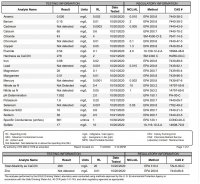Joseph Shelton
New Member
Hello all,
I'm looking to DIY install a water softener and filtration system at a home with well water I just bought in Michigan. This is my first time installing one so I'm looking for advice on the best way to accomplish what I want to do.
The test results attached are drawn through the kitchen sink after about 10 mins of flow, the water is untreated and coming straight from the well/pressure tank.
Goal: Soften the water, remove iron and remove slight rotten egg smell so that my wife is happy with the smell/taste of the water. And also to remove the arsenic that is present in the well water so it is safe for the little ones.
For sizing the softener I calculated the hardness at around 21 grains and I'm sizing the system for a family of four. So 4 people * 70 gal per day * 21 grains = 5,880 grains per day, which yields 41,160 grains per week. So for a regen cycle of once per week and oversized for better efficiency I figured a 64k grain softener with 2.0 cu.ft of resin would be the ideal choice. I was looking at the AFW Iron Pro2 softener (link), which I believe should also be able to effectively remove the 0.88ppm iron from the water.
For the Arsenic and rotten egg smell I was looking at the Express Water Heavy Metal Whole House Filter System (link). My thought here is that this would be after the pressure tank and before the softener. So it would function as the intake sediment filter and then this system uses a KDF85 for the middle cartridge, which I hope will remove Arsenic from the water. My understanding is that KDF85 only effectively removes one of two species of Arsenic that could be present in the water. So if there is any remaining post filter I will install a point of use RO system in the kitchen.
So overall system plan.
Well -> Pressure tank -> 3 Stage Filter with KDF85 -> 64k softener / iron filter -> house
Any thoughts or advice would be appreciated.
I'm looking to DIY install a water softener and filtration system at a home with well water I just bought in Michigan. This is my first time installing one so I'm looking for advice on the best way to accomplish what I want to do.
The test results attached are drawn through the kitchen sink after about 10 mins of flow, the water is untreated and coming straight from the well/pressure tank.
Goal: Soften the water, remove iron and remove slight rotten egg smell so that my wife is happy with the smell/taste of the water. And also to remove the arsenic that is present in the well water so it is safe for the little ones.
For sizing the softener I calculated the hardness at around 21 grains and I'm sizing the system for a family of four. So 4 people * 70 gal per day * 21 grains = 5,880 grains per day, which yields 41,160 grains per week. So for a regen cycle of once per week and oversized for better efficiency I figured a 64k grain softener with 2.0 cu.ft of resin would be the ideal choice. I was looking at the AFW Iron Pro2 softener (link), which I believe should also be able to effectively remove the 0.88ppm iron from the water.
For the Arsenic and rotten egg smell I was looking at the Express Water Heavy Metal Whole House Filter System (link). My thought here is that this would be after the pressure tank and before the softener. So it would function as the intake sediment filter and then this system uses a KDF85 for the middle cartridge, which I hope will remove Arsenic from the water. My understanding is that KDF85 only effectively removes one of two species of Arsenic that could be present in the water. So if there is any remaining post filter I will install a point of use RO system in the kitchen.
So overall system plan.
Well -> Pressure tank -> 3 Stage Filter with KDF85 -> 64k softener / iron filter -> house
Any thoughts or advice would be appreciated.

